

Canadian Best Practices Portal – CBPP. The Anishnawbe language expresses something that is happening in the active tense --each word is a whole story.
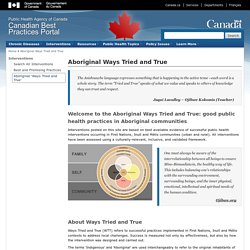
The term “Tried and True” speaks of what we value and speaks to others of knowledge they can trust and respect.Jaqui Lavalley – Ojibwe Kokomis (Teacher) Welcome to the Aboriginal Ways Tried and True: good public health practices in Aboriginal communities Interventions posted on this site are based on best available evidence of successful public health interventions occurring in First Nations, Inuit and Métis communities (urban and rural). Maternal Mental Health after Custody Loss and Death of a Child: A Retrospective Cohort Study Using Linkable Administrative Data. The loss of a child is traumatic for mothers.1 The grief associated with the death of a child, and the health and social implications of this grief, are well documented.
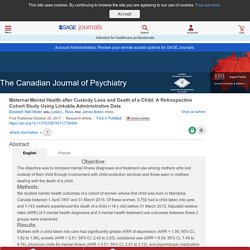
Mothers experiencing the death of a child have worse mental health than mothers who did not lose a child.2–4 Another type of loss parents can experience is the loss of custody of a child due to involvement with child protection services. This is often experienced as a “living death,” characterized by ambiguous loss, as parents no longer have control over how and when they can interact with their children and parents may go for long periods without being able to see their children.5 Distress experienced by mothers losing custody of their children is often overlooked, because they have failed society’s ideal of “good parenting.”6. Aboriginal Health - Health and Community Services.
This section contains information on topics that may be relevant and useful to Aboriginal Persons and any person interested on aboriginal topics including: The Aboriginal Health Transition Fund In an effort to improve the health status of Canada’s Aboriginal peoples, the federal government has partnered with the provinces and territories to deliver the Aboriginal Health Transition Fund (AHTF).
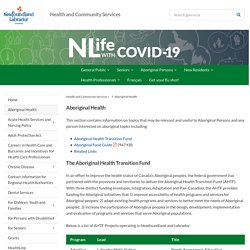
Frameworks Report English. Health inequalities and social determinants of Aboriginal Peoples' health. First Nations - stats on the percentage of Indigenous Canadians. Social Determinants of Health Inequities in Indigenous Canadians Through a Life Course Approach to Colonialism and the Residential School System. Government of Canada: Supporting Inuit children. 2017 - Ontario Ministers Outline Actions to Address First Nations Youth Health and Safety Crisis. <strong>We're sorry but Ontario Newsroom doesn't work properly without JavaScript enabled.
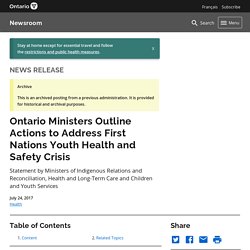
Please enable it to continue. </strong> Indigenous housing and health in the Canadian North: Revisiting cultural safety. View of Exploring the complex context of Canadian Indigenous maternal child-health through maternity experiences: the role of social determinants of health. The Mental Health and Well-Being of Canadian Indigenous and Non-Indigenous Women Abused by Intimate Partners. Autonomy needed to improve Indigenous Canadian health. Key Health Inequalities in Canada: A National Portrait – Executive Summary. Health inequalities in Canada exist, are persistent, and in some cases, are growingFootnote 1 Footnote 2 Footnote 3.
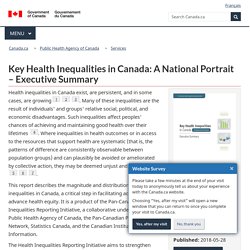
Many of these inequalities are the result of individuals' and groups' relative social, political, and economic disadvantages. Such inequalities affect peoples' chances of achieving and maintaining good health over their lifetimes Footnote 4. Social support and thriving health: a new approach to understanding the hea...: Discover for Scholarly Articles. Health services and social programs for Indigenous peoples. 13 10 14 afn report to un special rapporteur final en. 19 01 30 Health Summit Report DRAFT V4. Spheres of influence – IFHHRO. 3.
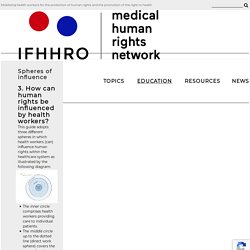
How can human rights be influenced by health workers? This guide adopts three different spheres in which health workers (can) influence human rights within the healthcare system as illustrated by the following diagram: The inner circle comprises health workers providing care to individual patients.The middle circle up to the dotted line (direct work sphere) covers the areas of work where a health worker is active including colleagues, superiors, patients and their families. The section past the dotted line (indirect work sphere) covers those areas of the work environment in which a health worker is not directly involved. Ecological Models - Rural Health Promotion and Disease Prevention Toolkit. The Social-Ecological Model: A Framework for Prevention. CDC’s goal is to stop violence before it begins.
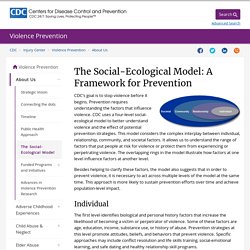
Prevention requires understanding the factors that influence violence. CDC uses a four-level social-ecological model to better understand violence and the effect of potential prevention strategies. This model considers the complex interplay between individual, relationship, community, and societal factors. It allows us to understand the range of factors that put people at risk for violence or protect them from experiencing or perpetrating violence. Core Principles of the Ecological Model. Multiple Influences on a Specific Health Behavior Among a myriad of public health issues, STDs are an especially notorious problem in public health.
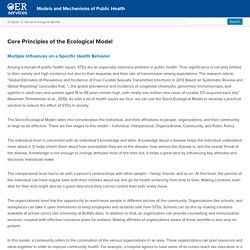
Their significance is not only limited to their variety and high incidence but also to their sequelae and their rate of transmission among populations. The research article, “Global Estimates of Prevalence and Incidence of Four Curable Sexually Transmitted Infections in 2012 Based on Systematic Review and Global Reporting” concludes that, “…the global prevalence and incidence of urogenital chlamydia, gonorrhea, trichomoniasis, and syphilis in adult men and women aged 15 to 49 years remain high, with nearly one million new cases of curable STI acquired each day” (Newman-Temmerman et al., 2015).
As with a lot of health issues we face, we can use the Socio-Ecological Model to develop a practical solution to reduce the effect of STDs in society. The individual level is concerned with an individual’s knowledge and skills. Udhr booklet en web. The ecological framework. SAGE Journals: Your gateway to world-class journal research. An Ecological Model Using Promotores de Salud to Prevent Cardiovascular Disease on the US-Mexico Border: The HEART Project - CDC. Hector Balcázar, PhD; Sherrie Wise, MPH; E.
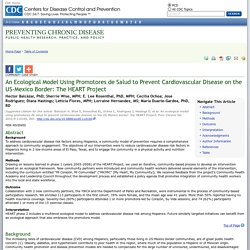
Lee Rosenthal, PhD, MPH; Cecilia Ochoa; Jose Rodriguez; Diana Hastings; Leticia Flores, MPH; Lorraine Hernandez, MS; Maria Duarte-Gardea, PhD, RD Suggested citation for this article: Balcázar H, Wise S, Rosenthal EL, Ochoa C, Rodriguez J, Hastings D, et al.